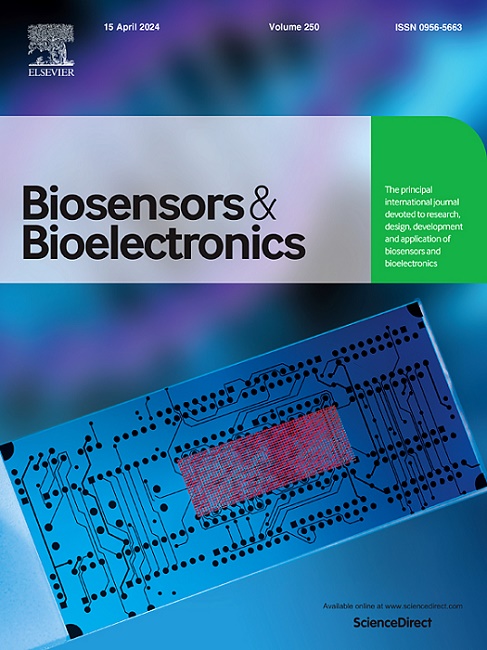基于磁性自组装的CRISPR/Cas14a与DNA walker集成用于人乳头瘤病毒16型癌蛋白E7超灵敏检测
IF 10.5
1区 生物学
Q1 BIOPHYSICS
引用次数: 0
摘要
为了提高人乳头瘤病毒16型癌蛋白E7 (HPV16 E7)在血清中生物标志物诊断的敏感性和选择性,建立了无标记/无酶电化学检测平台。该平台采用了一种通过差分脉冲伏安法(DPV)监测的“超级关断”纳米生物传感器。它将α-Fe2O3/Fe3O4@Au/Sub/BSA信号传输纳米介质的磁性自组装特性与CRISPR/Cas14a的高特异性和双足行走器(由两条ssDNA链组成的DNA行走器)的扩增能力结合在一起,增强了特异性和抗干扰性能,并在4°C下保持30天以上的稳定性。结果表明,与单独使用任一技术相比,walker和CRISPR联合使用具有更高的灵敏度和分析能力,检出限为67.17 fg mL-1,定量限为0.22 pg mL-1,血清样品回收率为98.46% ~ 115.78%。此外,该平台还被用于检测宫颈癌不同阶段小鼠模型的血清和组织样本,显著提高了早期诊断和预后评估的准确性和有效性。这种新方法有望成为即时临床检测hpv16e7的有效工具,有可能降低宫颈癌死亡率。本文章由计算机程序翻译,如有差异,请以英文原文为准。
CRISPR/Cas14a integrated with DNA walker based on magnetic self-assembly for human papillomavirus type 16 oncoprotein E7 ultrasensitive detection
To enhance the biomarker diagnostics sensitivity and selectivity of human papillomavirus type 16 oncoprotein E7 (HPV16 E7) in serum, a label/enzyme-free electrochemical detection platform was developed. This platform featured a type of "Super-turn-off" nanobiosensor monitored through differential pulse voltammetry (DPV). It integrated the magnetic self-assembly property of the α-Fe2O3/Fe3O4@Au/Sub/BSA signal transport nano-medium with the high specificity of CRISPR/Cas14a and the amplification capability of the bipedal walker (DNA walker composed of two ssDNA strands), resulting in the enhanced specificity and anti-interference performance while remaining stable at 4 °C for over 30 days. The results demonstrated that the combination of walker and CRISPR yielded superior sensitivity and analytical capability compared with using either technology alone, achieving a detection limit of 67.17 fg mL−1, a quantification limit of 0.22 pg mL−1, and serum sample recovery rates of 98.46%–115.78%. Additionally, this platform was applied to detect serum and tissue samples from mouse models at various stages of cervical cancer, significantly improving the accuracy and effectiveness of early diagnosis and prognostic evaluation. This novel approach held promise as an efficient tool for point-of-care clinical detection of HPV16 E7, potentially reducing cervical cancer mortality.
求助全文
通过发布文献求助,成功后即可免费获取论文全文。
去求助
来源期刊

Biosensors and Bioelectronics
工程技术-电化学
CiteScore
20.80
自引率
7.10%
发文量
1006
审稿时长
29 days
期刊介绍:
Biosensors & Bioelectronics, along with its open access companion journal Biosensors & Bioelectronics: X, is the leading international publication in the field of biosensors and bioelectronics. It covers research, design, development, and application of biosensors, which are analytical devices incorporating biological materials with physicochemical transducers. These devices, including sensors, DNA chips, electronic noses, and lab-on-a-chip, produce digital signals proportional to specific analytes. Examples include immunosensors and enzyme-based biosensors, applied in various fields such as medicine, environmental monitoring, and food industry. The journal also focuses on molecular and supramolecular structures for enhancing device performance.
 求助内容:
求助内容: 应助结果提醒方式:
应助结果提醒方式:


